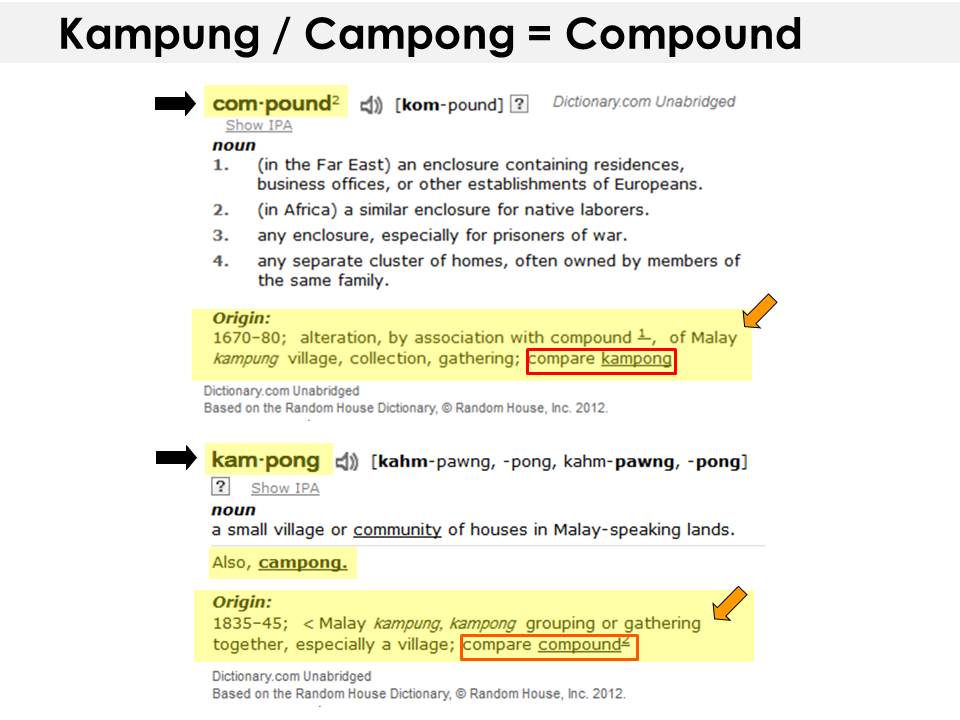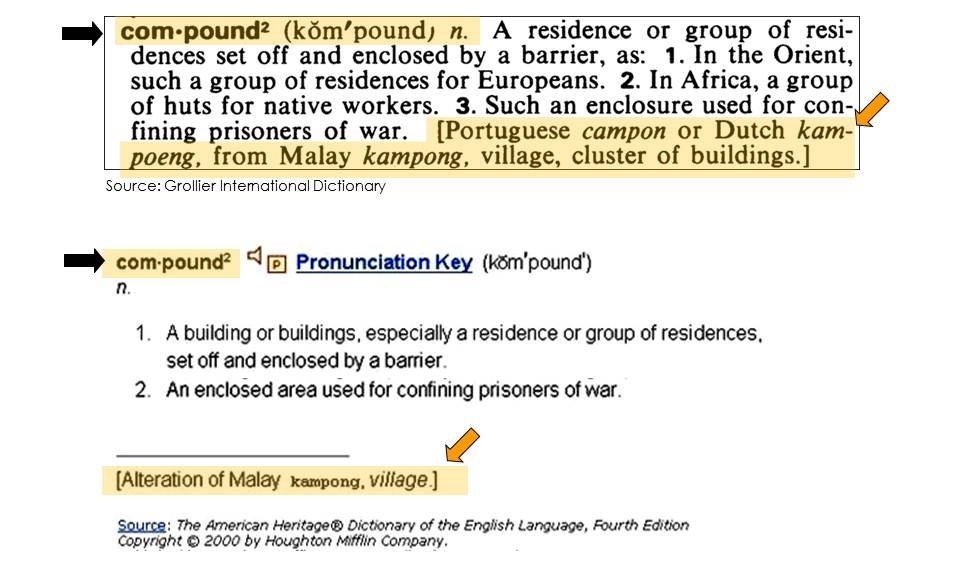Another little-known fact is that the English term ‘Compound’ (denoting the spatial entity applied to a two-storey house type) is in fact derived from the Malay term “Kampung”.
The words Campong / Kampong and ‘Compound’ in the English Language, through Portuguese, and Dutch usage.
The Malay word “Kampung” first entered Portuguese and Dutch in the 1600s and underwent various intermediate variant spellings.
The most common examples are (1) “Campon”/”Campong” and (2) “Campond”/”Kampund” (seen in some Dutch town maps for the East Indies).
(1) The word “Campong” officially stood for urban wards or nieighbourhoods in official town maps and plans drawn by European colonial authorities – Portuguese, Dutch, and English.
(2) The latter form entered English as “Compound” circa 1670-1680 (see below).
(3) The original form, spelt as “Kampong”, finally entered English official usage nearly 200 years later in 1836-45. It is usually glossed as “village”, losing its other meanings.
In summary, then, the term “Kampung” entered the English language in three ways:
- as “Campong”, where it denotes an urban district
- as “Compound”, where it denotes a cluster of buildings or unit of enclosure containing a building or set of buildings
- as “Kampong”, which is glossed as “village”
Kampung/Campong as house yard/compound and as urban ward
The word “kampung” is often glossed today as “village”. In fact the term has various meanings that are largely forgotten today, including as urban wards / town units.
In Malay the verb “berkampung” (to form a kampung) means to gather, to come together – it can be used to denote coming together for major festivities, and to form a settlement unit.
There is also the Malay term “kampung halaman” to denote one’s home village/town/neighbourhood, with the qualifier “compound-yard”.
And these various meanings have been adopted into the English language through three words: “Campong”, “Compound”, and “Kampong”.
The excerpts from dictionary entries below give the etymology (word origin) of the English word Compound from the Malay word “Kampung”, via Portuguese and Dutch adoptions, and also show the absorption of the words “Kampong” and “Campong” into English:
By the way, Kampung is a Malay word of Austronesian (Malayo-Polynesian) origin. It is not derived from Sanskrit, although many words in Malay are. The same word exists in Acehnese (gampong) with the same meaning; in Javanese it denotes also the gable roof form; in Cham and Ede (languages of Malayo-Polynesians in Central Vietnam) Kompong /Kpong means “settlement at a Boat Harbour” – a clue to the initial arrival of Malayo-speakers through maritime trade up the mainland Southeast Asian coasts and rivers (chiefly the Mekong, to Kompong Cham, Kompong Chhnang, Kompong Speu, etc).
Campong as Town units
“Kampung” in Malay can denote units of settlement in both rural and urban contexts:
Observe the names “Bugis Town”, “Chinese Town”, and “Malay Town” in this 1822 Map of Singapore:

Interestingly, the term “Campong” was used instead of “Town” in the official Town Plan for Singapore produced in 1822 by Capt James Franklin following instructions from Sir Thomas Stamford Raffles.
In this Plan (below), we see the terms “Chinese Campong”, “Chuliah Campong”, “Arab Campong” and “Bugis Campong”, instead of the terms “Malay Town”, “Chinese Town”, and “Bugis Town” which was seen in the 1822 map above.

Singapore’s Town Plan of 1823 by Lt Jackson, showing the structure of Campongs as town units.
Annotations by Imran bin Tajudeen.
Note that the position of the Bugis merchants of “Bugis Town” was shifted in the Jackson Plan (above) compared to its original location in the 1822 Franklin map (the 1822 Franklin Map below is rotated to the same orientation for comparison):
Kampung and Compound / Kampung House and Compound Houses
This is yet another meaning of the word Kampung in Malay – an enclosure for a building or a set of buildings, sometimes forming components in a city, in a suburb, or a village. Incidentally we have a related term: “kampung halaman” – literally, the “village-compound”.
In addition to Campongs (urban wards) such as Kampung Gelam, there were also many house Compounds in early Singapore Town, as shown in this map from 1846:
In fact the two-storey Rumah Limas was called the “Compound House” in most building drawings – well-known examples from Kampung Gelam include Istana Kampung Gelam, Gedung Kuning, and the main residence in Kota Nong Chik or Kota Alsagoff, at Java Road in Kampung Rochor.

Map of Singapore 1846 by J.T. Thomson, showing plot divisions for Compounds (fof detached houses) and for shophouses/rowhouses.
Gentle note/nudge:
The information laid out here is the fruit of research by Imran bin Tajudeen, and have been published in an academic journal article from 2005, and another academic article from 2007, and in a book chapter published in 2012. You are free to quote and use these materials, giving reference to either of these works in accordance with the basic etiquette in scholarship and academic work. Thank you.
Maklumat selanjutnya menyusul! More information coming soon!



Leave a Reply